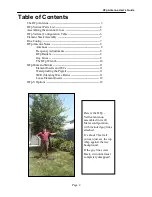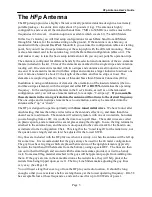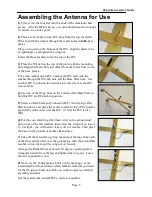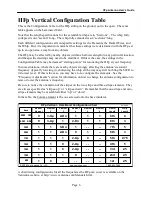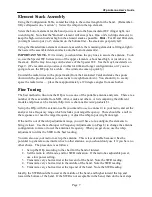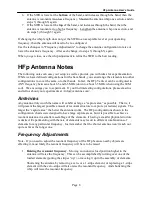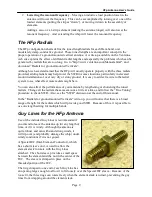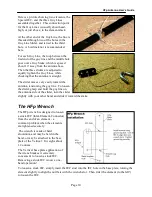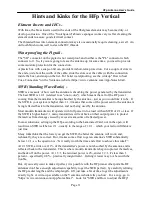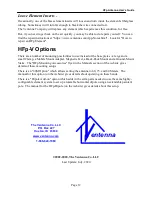
HFp Antenna User’s Guide
Page 11
Hints and Kinks for the HFp Vertical
Element Inserts and IECs -
With time, the brass inserts used in the ends of the fiberglass elements may become dirty, or
develop corrosion. One of the “Scotchguard” abrasive sponges works very well at cleaning the
element ends to assure good electrical contact.
The threaded brass inter-element connectors may also occasionally require cleaning, as well. An
old toothbrush works well to clean the IEC threads.
Waterproofing the Pigtail -
The "SO" connector on the pigtail is not waterproof, and neither is the "PL" connector which
connects to it. So, if you are going to leave the antenna up for some time, you need to provide
some moisture protection for the connection.
A plastic box with a snap-on lid can provide fair short-term protection. Cut a couple of slots in
the ends, just about the width of the cable, slide the slots over the cable (with the connection
inside the box), and snap on the lid. For better waterproofing, see the writeup "How to Seal
Coax Connectors" on the Ventenna website (https://www.ventenna.com/App-Notes.html).
SWR (Standing Wave Ratio) -
SWR is a measure of how well the antenna is absorbing the power generated by the transmitter.
The best SWR is 1.0:1 (referred to as "one-to-one"), which means that all of the RF power
coming from the transmitter is being absorbed by the antenna - just as you would like it to be. If
the SWR in your system is higher than 1:1, it means that some of the power sent to the antenna is
being reflected back to the transmitter, and not being used by the antenna.
Most modern transmitters will operate with full power into a load with an SWR of 2:1 or less. If
the SWR is higher than 2:1, many transmitters will cut back on their output power to protect
themselves from damage caused by excessive amounts of reflected power.
In most situations, setting up the HFp according to the Laminated Card, out in the open, will
result in an SWR well below 2:1 - usually in the range of 1.2:1 – which your radio will think is
just fine.
Many folks think that the lower you get the SWR, the better the antenna will work, and,
technically, they are correct. But, it takes some effort to get an antenna’s SWR substantially
below 1.2:1, so, the question is –“Is it really worth the time and effort to achieve this ideal?”.
At 2:1 SWR, a little over 11% of the transmitter's power is not absorbed by the antenna, and is
reflected back to the transmitter. This is where modern transmitters begin to protect themselves,
and back off on the power. At 1.5:1, the returned power is 4%, and at 1.2:1, it's less than 1
percent – specifically 0.8%
−
practically insignificant. Getting it lower may not be worth the
trouble.
But, if you really want to make it perfect, it is possible with the HFp (most other portable HF
antennas don't have enough adjustment capability to get the SWR perfect), by carefully refining
the HFp radial lengths and the whip length. It'll just take a bit of time to get the adjustments
exactly right. A write-up available on the Ventenna website tells you how. For a copy, go to
"https://www.ventenna.com/App-Notes.html ". Look for "SWR and How to adjust the HFp".


